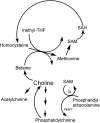Epigenetic mechanisms for nutrition determinants of later health outcomes
- PMID: 19261726
- PMCID: PMC2677001
- DOI: 10.3945/ajcn.2009.27113B
Epigenetic mechanisms for nutrition determinants of later health outcomes
Abstract
Epigenetic marking on genes can determine whether or not genes are expressed. Epigenetic regulation is mediated by the addition of methyl groups to DNA cytosine bases, of methyl and acetyl groups to proteins (histones) around which DNA is wrapped, and by small interfering RNA molecules. Some components of epigenetic regulation have evolved to permit control of whether maternal or paternal genes are expressed. The epigenetic imprinting of IGF2 expression is an example of maternal and paternal epigenetic marking that modulates fetal growth and fetal size. However, epigenetic regulation also permits the fetus and the infant to adapt gene expression to the environment in which it is growing; sometimes when this adjustment goes awry, the risk of chronic disease is increased. Recent progress in the understanding of nutritional influences on epigenetics suggests that nutrients that are part of methyl-group metabolism can significantly influence epigenetics. During critical periods in development, dietary methyl-group intake (choline, methionine, and folate) can alter DNA and histone methylation, which results in lifelong changes in gene expression. In rodent models, pregnant dams that were fed diets high in methionine, folic acid, and choline produced offspring with different coat colors or with kinked tails. A number of syndromes in humans can be caused by defective epigenetic regulation, including Rett syndrome. There are interesting examples of the effects of nutrition in early life that result in altered health in adults, and some of these could be the result of altered epigenetic regulation of gene expression.
Figures


References
-
- Jaenisch R. DNA methylation and imprinting: why bother? Trends Genet 1997;13:323–9 - PubMed
-
- Robertson KD, Wolffe AP. DNA methylation in health and disease. Nat Rev Genet 2000;1:11–9 - PubMed
-
- Killian JK, Byrd JC, Jirtle JV, et al. M6P/IGF2R imprinting evolution in mammals. Mol Cell 2000;5:707–16 - PubMed
-
- Li YF, Langholz B, Salam MT, Gilliland FD. Maternal and grandmaternal smoking patterns are associated with early childhood asthma. Chest 2005;127:1232–41 - PubMed
Publication types
MeSH terms
Substances
Grants and funding
LinkOut - more resources
Full Text Sources
Miscellaneous

